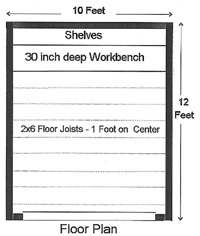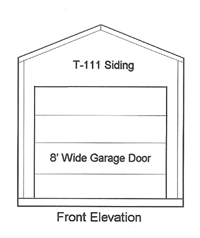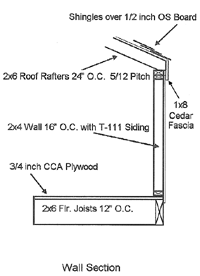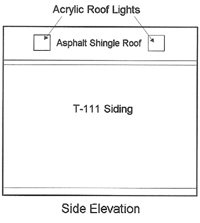Sheds
DEAR TIM: My husband and I have outgrown our garage. We went shopping for a freestanding wood storage building. The outside appearance of the buildings looked nice, however they all seemed very flimsy. I feel I can use standard materials and build a better building myself. Do you think the average homeowner can tackle this project? What size shed do you recommend? S.V.
DEAR S. V.: I see you have the same problem that I do - too much stuff! Outdoor sheds prevent car damage, and reduce clutter. Sheds make a great place to do projects that might otherwise create a mess or fumes in your home. I have built many of these sheds for my past clients. A detail-oriented homeowner and a helper using four days worth of vacation time can build a substantial shed. Building your shed as a DIY project will save lots of money.

A 10-foot wide by 12-foot deep shed is a very popular size. This size permits you to include a fantastic 10-foot long, 30-inch deep work bench inside on the back wall. A series of shelves above the workbench will provide vast amounts of storage space for boxes, paint cans, garden chemicals, etc. This design allows for ample floor space for lawn mowers, wheel barrows, snow blowers, and yard tools.
Many of these sheds have no foundation. They simply rest on solid concrete blocks, which are spaced at 2-foot intervals. Crushed gravel can be used to level the blocks if your lot is relatively flat. If your lot is sloped, you may have to use posts which project from the floor system to the concrete blocks.
People who live in a cold climate, should place the concrete blocks or posts on concrete piers. These small piers are placed below the level which frost penetrates the soil. Without this protection, the soil can freeze and heave. This can cause your building to twist. Doors and windows may not operate properly until the spring thaw.
If you live in an area subjected to high winds or storms, it is important to include special hold-down anchors at each corner of the shed. These anchors bolt to the shed walls, and then connect to pieces of steel or blocks of concrete buried next to the building. The anchors are easy to install. Without this protection, it is possible for your building to be blown over or across your yard during severe storms.
I recommend that you install a simple metal overhead garage door to give you excellent access to the building. A standard door is 8 feet wide and 7 foot tall. They provide excellent security and often can be installed by a professional for $350 or less.
 |

|
Be sure to use chemically-treated lumber for your floor joists and plywood flooring. Without this protection, the floor system of your shed would begin to rot in a very short period of time. I also recommend that you stretch a sheet of cross laminated polyethylene sheeting over the floor joists before nailing the plywood in place. This will block water vapor from the soil which can cause your tools to rust.

Natural light can be introduced into the shed by using pieces of clear acrylic. These can be placed over openings cut in the roof. Simply overlap the acrylic 2 inches on each edge and the bottom. Slide the top of the acrylic up under the shingles at the top of the opening. Apply clear silicone caulk under the edges of the acrylic to stop wind blown rain. If you can afford real skylights, install these instead of the plastic panels.
It is also a good idea to install a turbine roof vent. This device will exhaust hot air from the shed, and help keep the shed comfortable during periods of hot weather.